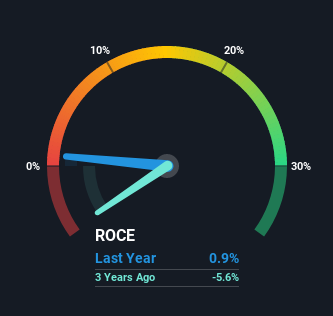- United States
- /
- Consumer Durables
- /
- NasdaqCM:KOSS
Koss (NASDAQ:KOSS) Could Be Struggling To Allocate Capital
Ignoring the stock price of a company, what are the underlying trends that tell us a business is past the growth phase? More often than not, we'll see a declining return on capital employed (ROCE) and a declining amount of capital employed. This indicates the company is producing less profit from its investments and its total assets are decreasing. On that note, looking into Koss (NASDAQ:KOSS), we weren't too upbeat about how things were going.
What is Return On Capital Employed (ROCE)?
Just to clarify if you're unsure, ROCE is a metric for evaluating how much pre-tax income (in percentage terms) a company earns on the capital invested in its business. The formula for this calculation on Koss is:
Return on Capital Employed = Earnings Before Interest and Tax (EBIT) ÷ (Total Assets - Current Liabilities)
0.009 = US$188k ÷ (US$24m - US$3.1m) (Based on the trailing twelve months to December 2020).
Therefore, Koss has an ROCE of 0.9%. Ultimately, that's a low return and it under-performs the Consumer Durables industry average of 14%.
See our latest analysis for Koss

Historical performance is a great place to start when researching a stock so above you can see the gauge for Koss' ROCE against it's prior returns. If you'd like to look at how Koss has performed in the past in other metrics, you can view this free graph of past earnings, revenue and cash flow.
What Can We Tell From Koss' ROCE Trend?
There is reason to be cautious about Koss, given the returns are trending downwards. To be more specific, the ROCE was 4.8% five years ago, but since then it has dropped noticeably. Meanwhile, capital employed in the business has stayed roughly the flat over the period. Companies that exhibit these attributes tend to not be shrinking, but they can be mature and facing pressure on their margins from competition. If these trends continue, we wouldn't expect Koss to turn into a multi-bagger.
The Key Takeaway
In the end, the trend of lower returns on the same amount of capital isn't typically an indication that we're looking at a growth stock. The market must be rosy on the stock's future because even though the underlying trends aren't too encouraging, the stock has soared 776%. In any case, the current underlying trends don't bode well for long term performance so unless they reverse, we'd start looking elsewhere.
If you want to continue researching Koss, you might be interested to know about the 4 warning signs that our analysis has discovered.
For those who like to invest in solid companies, check out this free list of companies with solid balance sheets and high returns on equity.
When trading Koss or any other investment, use the platform considered by many to be the Professional's Gateway to the Worlds Market, Interactive Brokers. You get the lowest-cost* trading on stocks, options, futures, forex, bonds and funds worldwide from a single integrated account. Promoted
Valuation is complex, but we're here to simplify it.
Discover if Koss might be undervalued or overvalued with our detailed analysis, featuring fair value estimates, potential risks, dividends, insider trades, and its financial condition.
Access Free AnalysisThis article by Simply Wall St is general in nature. It does not constitute a recommendation to buy or sell any stock, and does not take account of your objectives, or your financial situation. We aim to bring you long-term focused analysis driven by fundamental data. Note that our analysis may not factor in the latest price-sensitive company announcements or qualitative material. Simply Wall St has no position in any stocks mentioned.
*Interactive Brokers Rated Lowest Cost Broker by StockBrokers.com Annual Online Review 2020
Have feedback on this article? Concerned about the content? Get in touch with us directly. Alternatively, email editorial-team (at) simplywallst.com.
About NasdaqCM:KOSS
Koss
Engages in the design, manufacture, and sale of stereo headphones and related accessories in the United States, Sweden, the Czech Republic, Japan, Malaysia, Korea, Canada, and internationally.
Flawless balance sheet with very low risk.
Market Insights
Community Narratives



